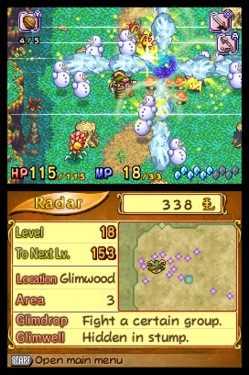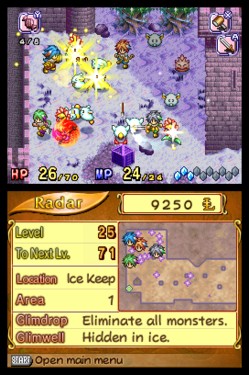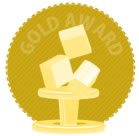Children of Mana (Nintendo DS) Review
By Adam Riley  15.01.2007
15.01.2007

The World of Mana is now in full flow over in Japan, but Europe is about to get its first dose of the action with Children of Mana, the début title in what Square Enix is hoping will be the full-on resurrection of a franchise that was unfairly left lying around, with just two recent updates in the form of the PSone’s Legend of Mana and the remake of Seiken Densetsu, Sword of Mana (which was developed by an outside company – Nintendo’s very own Brownie Brown). What people are eager to know, though, is whether this is a strong enough entry to jump-start the series once more…
The Mana part of the title is an integral part of the story for all entries in the franchise, with this particular game focusing on the Sword of Mana and its special power. This time round, the story is set in the past on an island called Illusia that has floated to the surface of the world. In the centre of this new isle is an ancient tree, the Mana Tree. Sadly chaos ensued shortly after until at long last salvation appeared in the form of a boy, girl and the legendary holy sword (very apt give the translation of the Japanese name Seiken Densetsu...). Now things are starting on the road to recovery...or are they?
For those of you with fond memories of the SNES game and people who loved the style of the GBA remake of the original, you are in for a treat with Children of Mana. That hand-drawn, 2D approach that comes full to the brim with rich colours, lively backgrounds and wonderfully animated enemies is not only back, but also far better than ever before. Whilst the Japanese-only Seiken Densetsu 3 may still appear a superior offering, Children of Mana actually takes those graphics and tidied them up a treat to make this one of the most attractive DS games so far.

And again, with the soundtrack, some of the music within is so extremely melodic and memorably that headphones definitely are a must to get the full experience. Sadly, though, not all of the tunes are quite as strong as in previous Mana outings, yet they still manage to keep their head above the majority of competitors on the DS…As for sound effects, well, there are the obligatory grunts and noises that accompany various actions such as opening chests, firing off weapons and unleashing magic – in other words, nothing is missing and the result is definitely a pleasing one.
As for the game itself, it is definitely not what you would remember in terms of overall gameplay. Sure, the main characters will all look vaguely familiar, the worlds will certainly give you a feeling of déjà vu and the collection of enemies are all lifted from previous entries in the Mana series (yes, including the US-only PSone game Legend of Mana and Seiken Densetsu 3 – so they will in fact be ‘new’ to most European gamers), but the meat of the action is distinctly different. This has led to much debate over whether Children is a ‘true’ Mana follow-up and if the change has indeed been a positive one.
First of all, the developer is Nex Entertainment, a group that has previously worked on Sega’s Shining Soul, a very strong dungeon crawling RPG series for the GBA, as well as Shining Tears on the PS2. Secondly, this is indeed a dungeon crawling game! There has already been one dungeon crawling game released for the DS here in Europe late last year, in the form of Pokémon Mystery Dungeon, and in a way Children of Mana bares a striking resemblance to it. However, whilst the Pocket Monsters spin-off from ChunSoft proves to be limited in its appeal due to the game basically repeating itself until the credits roll, CoM far outclasses it thanks to the spectacular graphical quality, strong atmospheric soundtrack, as well as being extremely varied in its execution.

You choose one of three characters and play the game from a main hub-system, which is in the form of the first village you encounter (and a gorgeous looking village it is, complete with such a serene theme that it never grows tiring despite you spending SO much time there!). From here on in you are given missions by the various inhabitants, be they human, animal or of the spirit kind – anyone (or anything) you talk to will either give you information, provide a service (buying/selling items, special gems, armour, weapons and so on), offer special gifts or move the main story along by requesting you complete a certain new task. A nice touch is that you cannot simply store up ridiculous amounts of money then rush off to buy all the best equipment to help you breeze through the game. Instead, every weapon, piece of armour and accessory item has a ‘level’, meaning you must reach that level of experience before you can make use of it. This definitely gives you more of a purpose for boosting your experience rather than skipping by as many enemies as you can.
Armour is standard defence-boosting equipment, accessories can have a range of different attributes and there are four types of weapon – sword, flail, bow and hammer. Everything is of the utmost importance and if you do not bother to upgrade as often as possible then the consequences will be suffered later on as death imposes itself upon you with due haste. In terms of these weapons, you only start with the sword, but eventually obtain the next three as you progress through the main missions. Speaking of which, the ‘dungeons’ in this game are not quite what you would imagine. Nex has taken the route of changing the format as much as possible and keeping the feel of the Mana world. Therefore, we are treated to a difficult desert area, a lively leafy location, a tower of trepidation and an…’intense’…icy world (phew), to name just a few examples. Again, differing from Chunsoft’s Pokémon game, the enemies in each dungeon have varying attack methods, which adds so much to the action and considerably helps to stop boredom setting in (remember, you will be sent back to the same locations on many an occasion to complete a ‘new’ task, so there was indeed the potential for tedium to creep in).

To move through a ‘dungeon’, you must locate a special crystal and take it to a warp location. Crystals may be anywhere – hidden in a jar, inside a plant or even may only appear when a group of enemies have been despatched. The same goes for the Gleamwells (warp spots) later in the game as well (at first they are just on-show somewhere in a stage), again adding a pleasing new aspect to the game. As stated earlier, enemies from previous games make an appearance, so there are hooded creatures that fire arrows at you, different coloured Rabites, strange fish that bounce around spitting bubbles at you, stacks of evil bats, rabid wolves, devious hedgehogs that dive into the ground and charge you from below, the infamous ducks with their long chains and even large pumpkins. Thankfully you are well equipped to defeat them in fine fashion. Holding down the attack button builds up a special move (such as a shield from the sword that deflects projectiles or throws the flail straight forward, which comes in very handy when grabbing items from across large expanses of spikes), one of the eight elemental spirits can be called upon to unleash powerful magic and then there are the gems that can help out considerably.
Yes, other than the various tasks asked of you that extend the game, there are gems that can be collected and added to your character to change their stats, increase the use of certain items and even boost your Fury attack (a special gauge that fills up the more you attack things, then can be unleashed by pressing ‘select’ to let you attack large groups in a much more efficient way for a short time). These are dropped by enemies, can be bought in the village or even two different ones can be fused together to create fantastic new ones (remembering all the while that you can only equip a certain amount at any one time…so balancing which are best is part of the fun!). They can really work to your advantage as you reach some of the later bosses that would otherwise have you pulling your hair out in frustration. As for the bottom screen, it is not used for character control, instead showing useful information, such as where crystals and warp spots are hidden, what your next objective is (extra tasks are found on the menu screen under ‘status’), as well as where enemies crop up around the stage you are currently on. Oh, and of course the longevity is helped along the way by letting four players jump into the action and solve quests together…Sounds good? It is much more than that!

Cubed3 Rating
Exceptional - Gold Award

Gamers expecting a game in the same vein as Secret of Mana or Sword of Mana may come away disappointed by the gameplay change, but if you wander in with an open mind you will find that this transformation of the Mana world is fantastic. Dungeon crawling games can wear thin over time, but Children of Mana exudes enough class to last the whole adventure...

![]() 9/10
9/10
![]() 10/10
(6 Votes)
10/10
(6 Votes)
 Out now
Out now  Out now
Out now  Out now
Out now  Out now
Out now Comments
Comments are currently disabled

 Sign In
Sign In Game Details
Game Details Subscribe to this topic
Subscribe to this topic Features
Features





 Top
Top

